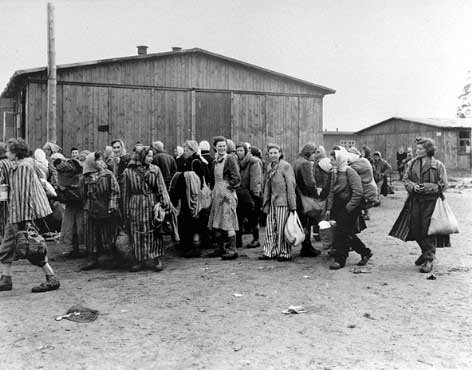The Deportation of the Hungarian
Jews

Bergen-Belsen camp,
April 1945
According to Eberhard Kolb, who wrote
a book entitled "Bergen-Belsen from 1943 to 1945,"
Reichsführer-SS Heinrich Himmler had opened a special section
at the Bergen-Belsen exchange camp on July 8, 1944, where 1,683
Hungarian Jews from Budapest had been brought. The Jews in the
Hungarian section were treated better than all the others at
Bergen-Belsen. They received better food and medical care and
were not required to work nor to attend the daily roll calls.
They wore their own clothes, but were required to wear a yellow
Star of David patch. The Bergen-Belsen camp had different categories
of prisoners, and the Hungarian Jews were in the category of
Preferential Jews (Vorzugsjuden) because they were considered
desirable for exchange purposes.
 Prisoners at the Bergen-Belsen
camp
Prisoners at the Bergen-Belsen
camp
The first transport of 318 "exchange
Jews" left the Bergen-Belsen Hungarian camp on August 18,
1944, bound for Switzerland. On August 20th, the trainload of
Hungarian Jews arrived in Bregenz and then went on to St. Gallen
the next day.
Hitler had given his permission in December
1942 to release Jews for ransom, so Himmler was not going against
established Nazi policy. On August 21, 1944, three SS officers
(Kurt Becher, Max Grüson and Hermann Krumey) who were representing
Himmler, and a representative of the Budapest Jews, Rudolf Kastner,
met with Saly Mayer, a leading member of the Jewish Community
in Switzerland. The meeting took place in the middle of a bridge
at St. Margarethen, on the border between Germany and Switzerland,
because Mayer refused to enter Germany and he also did not want
the SS men to enter Switzerland, according to Yehuda Bauer. Becher
asked for farm machinery and 10,000 trucks, and in return, he
promised to free 318 Hungarian Jews from Bergen-Belsen. In a
show of good faith, the train with the 318 Jews was already waiting
at the Swiss border. Mayer offered minerals and industry goods
instead of the trucks. According to Yehuda Bauer, Becher later
claimed that he had persuaded Himmler not to deport the Budapest
Jews, and that was why Himmler issued an order to stop the deportation
three days later.
A second group of 1,368 Hungarian Jews
left the Bergen-Belsen detention camp on December 4, 1944 and
entered Switzerland just after midnight on December 7th, according
to Yehuda Bauer. Altogether, there was a total of 2,896 Jews
released for ransom, including a transport of 1,210 Jews from
the Theresienstadt Ghetto who entered Switzerland on February
7, 1945.
After the departure of the second Hungarian
transport to Switzerland in December, more transports from Budapest
continued to arrive at Bergen-Belsen and the Hungarian section
remained in existence there until April 15, 1945 when the camp
was voluntarily turned over to the British by Heinrich Himmler.
According to Eberhard Kolb, it was a transport of Hungarian Jews
in February 1945 that bought in the lice that started a typhus
epidemic in the camp. The delousing facilities in the camp had
been temporarily out of order at that time.
After the Hungarian Jews had entered
Switzerland, there were false reports by the Swiss press that
the Jews were being ransomed in exchange for asylum for 200 SS
officers who were planning to defect. When Hitler heard this,
from Ernst Kaltenbrunner who was no friend of Himmler, he ordered
all further releases of Jews for ransom to stop.
Between April 6 and April 11, 1945 the
Hungarian Jews were evacuated from Bergen-Belsen on the orders
of Himmler who was planning to use them as bargaining chips in
his negotiations with the Allies. Himmler still had hopes that
the Western Allies would join the Germans in fighting against
the Communist Soviet Union. The next day, on April 12, 1945,
President Franklin D. Roosevelt died and Hitler and Himmler truly
believed that America would now join them in their war against
the Communists.
The Jews in the Star Camp and also in
the Neutrals Camp were also evacuated, along with the Hungarians,
in three trains which held altogether about 7,000 Jews who were
considered "exchange Jews." One of these trains arrived
with 1,712 Jews on April 21, 1945 in the Theresienstadt Ghetto
in Czechoslovakia. Two weeks later, the Theresienstadt Ghetto
was turned over to the Red Cross, just before Soviet troops arrived
with Russian doctors to take care of the prisoners who were sick
with typhus.
The other two trains from Bergen-Belsen
never made it to Theresienstadt because they had to keep making
detours due to frequent Allied air attacks, according to Eberhard
Kolb. One of the trains finally stopped on April 14th near Magdeburg
in northern Germany; the guards ran away and the Jews on the
train were liberated by American troops. The third train halted
on April 23, 1945 near the village of Tröbitz in the Niederlausitz
region; they were liberated by Soviet troops after the guards
escaped.
This page was last updated on January
10, 2007
|